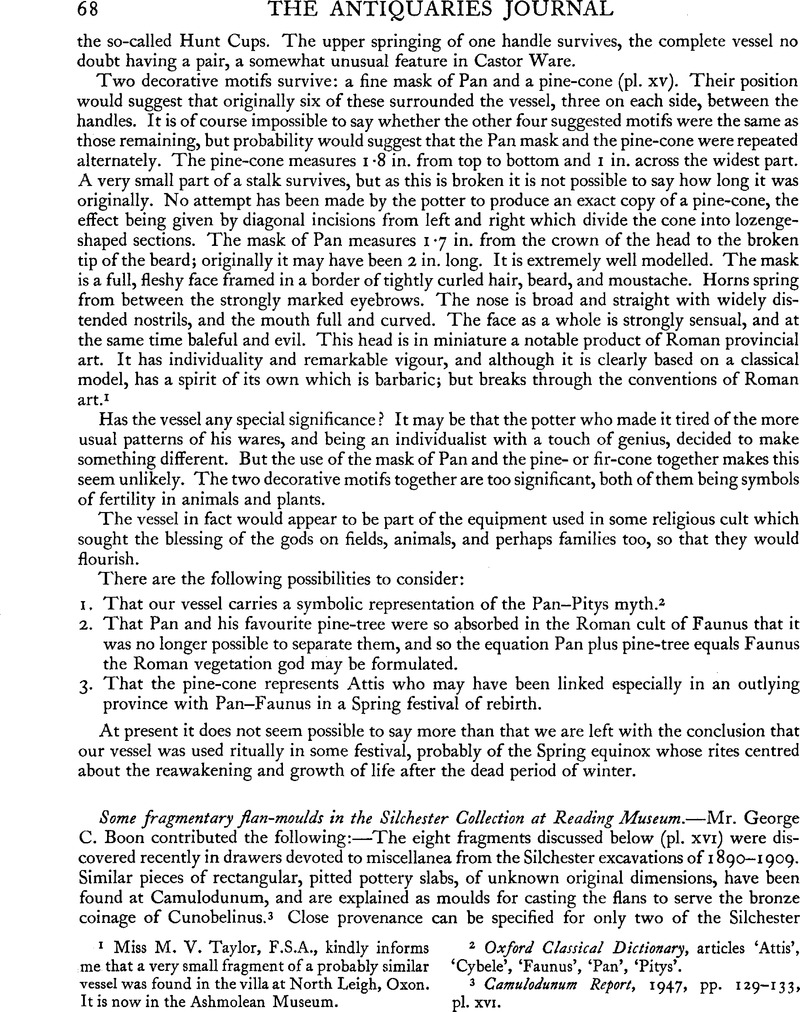Article contents
Some fragmentary flan-moulds in the Silchester Collection at Reading Museum
Published online by Cambridge University Press: 29 November 2011
Abstract

- Type
- Notes
- Information
- Copyright
- Copyright © The Society of Antiquaries of London 1964
References
page 68 note 3 Camulodunum Report, 1947, pp. 129-133, pl. XVI.
page 69 note 1 Archaeologist, lxii, 326. Omitted on sections, 320, fig. 3.
page 69 note 2 Such deviations from a cylindrical shape would be due to the displacement of the clay as successive pits were stamped.
page 69 note 3 Mr. M. R. Hull, F.S.A., has kindly checked this point for me.
page 69 note 4 Experiments with plasticine showed that slight depressions between pits were normal and to be expected.
page 69 note 5 I am indebted to Dr. H. J. Plenderleith, F.S.A., Dr. A. A. Moss, and Mr. H. Barton of the British Museum Research Laboratory for these findings.
page 69 note 6 Allen, , Archaeologia, xc, 7-8, pi. 1, 14, 15.Google Scholar
page 69 note 7 Four specimens known according to Allen, op. cit., p. 8; five, with a possible sixth, according to Mack, Coinage of Ancient Britain, 1953, p. 35.
page 69 note 8 About 16 and 18 grains respectively.
page 70 note 1 Mr. H. Barton.
page 70 note 2 Camulodunum Report, p. 132.
page 70 note 3 Archaeologia, lxii, 324.
page 70 note 4 Ibid. xcii, 129-130.
page 70 note 5 Ibid. lxii, 326.
page 70 note 6 List of main finds, ibid, lxii, 326. The two whole pots, as May, 1916, pi. LXVIII, 144, and as pi. LXXVIII, 6.
page 70 note 7 Archaeologia, xcii, 152-6, fig. II, pl. XXXVII b.
page 70 note 8 As remarked above, the dating to be assigned to moulds of this type appears to be almost certainly an exclusively pre-Roman. But is it quite impossible that the use of a traditional method of making flans should have been continued into the early Roman period? Ancient British coins were current down to the second century in the Cranborne-Hengist-bury region, and elsewhere seem to have been in use together with Roman issues (Allen, , op. cit. 37Google Scholar; Sutherland, R.-B.Imitations of Bronze Coins of Claudius I, 1935, II, fn. 18Google Scholar). This state of affairs was no doubt occasioned by a dearth of Roman small change in the years immediately following. the initial conquest, as attested by the multitude of copies of Claudian asses which exist. Among the client Iceni of Claudian times, the flan-moulding process appears to have been still in use (Antiy. Journ. xxi, 50, fig. 8c).
- 1
- Cited by




